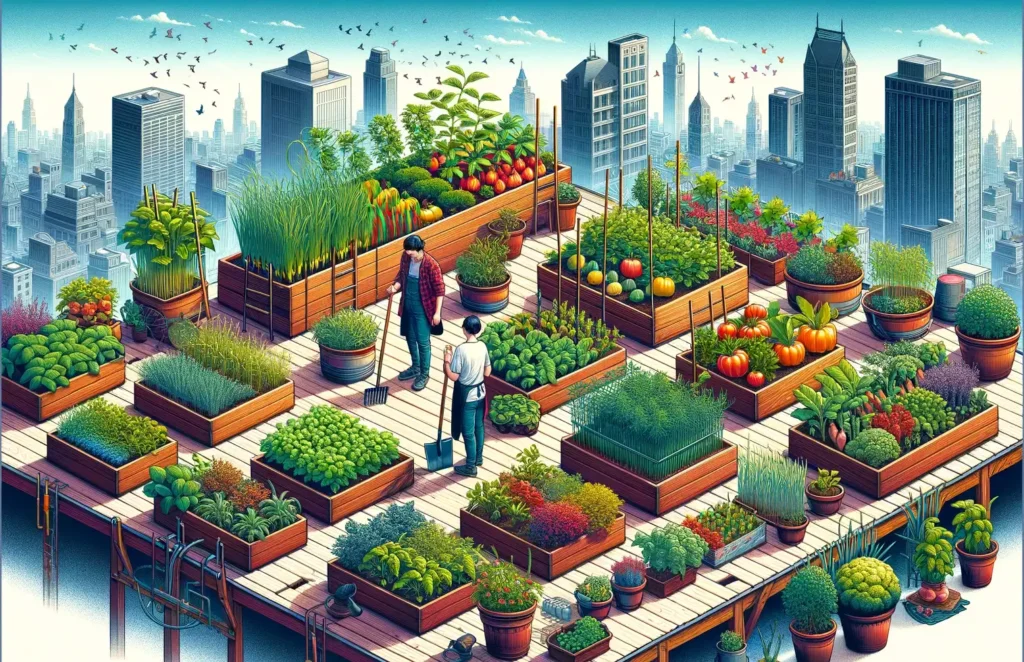
Rooftop Garden A vivid and detailed medium shot illustration of a rooftop garden. The scene shows a variety of vegetables and herbs growing in pots and planters on a4.webp.webp
Definition: Rooftop Gardens
Rooftop gardens refer to the practice of growing plants, vegetables, fruits, and flowers on the roofs of buildings. This form of urban agriculture utilizes underused rooftop spaces to create green, productive areas in urban environments. Rooftop gardens can range from small container gardens to extensive green roofs and can provide numerous environmental, economic, and social benefits.
Understanding Rooftop Gardens
Introduction
Rooftop gardens are becoming increasingly popular in cities around the world as a way to maximize space, improve air quality, and enhance urban sustainability. By transforming unused rooftop spaces into productive gardens, cities can address food security, reduce the urban heat island effect, and promote biodiversity. These gardens can be found on residential buildings, commercial properties, schools, and public spaces.
Fall off the barn roof and busted your keister? Life on the farm or ranch can be tough on the bum. Need a break? Laugh it off at FarmerCowboy.com, the #1 farm humor site. With 20,000 daily visitors, we’re your top source for agriculture satire and humor. Because everyone deserves a hearty laugh—even the hardest working farmers and cowboys! Join us and turn those long days into fun tales at FarmerCowboy.com.
Benefits of Rooftop Gardens
1. Maximizing Space
Rooftop gardens make use of otherwise unused space, contributing to urban greening without requiring additional land.
2. Improving Air Quality
Plants in rooftop gardens can filter pollutants and carbon dioxide from the air, improving overall air quality in urban areas.
3. Reducing Urban Heat Island Effect
Rooftop gardens help to cool buildings and surrounding areas by providing shade and releasing moisture into the air through a process called evapotranspiration.
4. Enhancing Food Security
By growing fruits, vegetables, and herbs, rooftop gardens can provide fresh, locally grown produce, reducing the reliance on imported food and enhancing food security.
5. Promoting Biodiversity
Rooftop gardens create habitats for birds, insects, and other wildlife, promoting urban biodiversity.
6. Insulating Buildings
Green roofs can improve the thermal insulation of buildings, reducing heating and cooling costs.
7. Managing Stormwater
Rooftop gardens can absorb rainwater, reducing runoff and decreasing the burden on urban drainage systems.
Types of Rooftop Gardens
1. Extensive Green Roofs
Extensive green roofs are lightweight systems with a shallow layer of soil, designed primarily for environmental benefits such as stormwater management and insulation. They typically support hardy, low-maintenance plants like sedums and grasses.
2. Intensive Green Roofs
Intensive green roofs, also known as rooftop gardens, have deeper soil layers and can support a wide variety of plants, including trees, shrubs, and vegetables. They require more maintenance and are often designed for recreational use.
3. Container Gardens
Container gardens use pots, planters, and raised beds to grow plants on rooftops. They are flexible and can be easily rearranged, making them suitable for smaller spaces or temporary installations.
4. Hydroponic Gardens
Hydroponic gardens grow plants in a nutrient-rich water solution without soil. This method is efficient in terms of space and water use and can be used to grow a wide variety of crops on rooftops.
Challenges of Rooftop Gardens
Structural Load
Not all buildings are designed to support the additional weight of a rooftop garden. Structural assessments and reinforcements may be necessary.
Water Management
Rooftop gardens require effective irrigation systems to ensure plants receive adequate water. Rainwater harvesting systems can be integrated to reduce reliance on municipal water supplies.
Accessibility
Access to rooftops can be challenging, particularly for maintenance and harvesting. Safe and convenient access routes must be considered in the design.
Initial Costs
The installation of rooftop gardens can be costly, requiring investment in waterproofing, drainage, and structural reinforcement. However, long-term savings in energy costs and increased property value can offset these initial expenses.
Steps to Create a Successful Rooftop Garden
1. Conduct a Structural Assessment
Before starting a rooftop garden, conduct a structural assessment to determine if the building can support the additional weight. Consult with a structural engineer if necessary.
2. Plan the Layout
Design a layout that maximizes the use of available space while considering accessibility, sunlight, and wind exposure. Plan for pathways, seating areas, and planting zones.
3. Install Waterproofing and Drainage
Ensure the roof is properly waterproofed to prevent leaks. Install a drainage system to manage excess water and prevent root rot.
4. Choose the Right Plants
Select plants that are suitable for the rooftop environment, considering factors such as wind, sunlight, and temperature. Drought-tolerant and low-maintenance plants are ideal for extensive green roofs.
5. Set Up Irrigation
Install an efficient irrigation system to provide consistent water to the plants. Drip irrigation and rainwater harvesting systems are effective options.
6. Maintain the Garden
Regular maintenance is essential for the success of a rooftop garden. This includes watering, fertilizing, pruning, and monitoring for pests and diseases.
Case Studies of Rooftop Garden Success
1. Brooklyn Grange (New York City, USA)
Brooklyn Grange operates the largest rooftop soil farms in the world, located on two rooftops in New York City. The farms produce a wide variety of vegetables, herbs, and honey, supplying local markets and restaurants while hosting educational programs and community events.
2. Namba Parks (Osaka, Japan)
Namba Parks is a commercial complex with a multi-level rooftop garden featuring trees, shrubs, waterfalls, and vegetable plots. The garden provides a green oasis in the heart of the city, enhancing biodiversity and offering recreational space for visitors.
3. University of Warsaw Library (Warsaw, Poland)
The rooftop garden of the University of Warsaw Library spans over one hectare and includes lawns, flower beds, and small ponds. It provides a peaceful retreat for students and visitors, contributing to urban biodiversity and insulation for the building.
Conclusion
Rooftop gardens offer numerous environmental, economic, and social benefits, making them a valuable addition to urban landscapes. By transforming unused rooftop spaces into green, productive areas, cities can enhance food security, reduce environmental impact, and create vibrant community spaces. Understanding the benefits, challenges, and best practices for creating rooftop gardens can help urban planners, architects, and individuals make informed decisions and successfully implement these innovative green spaces.
How Knowledge of Rooftop Gardens Can Help Urban Farmers
Understanding rooftop gardens, including their benefits, types, and challenges, can help urban farmers make informed decisions and adopt best practices. Knowledge of plant selection, irrigation systems, and structural considerations can empower urban farmers to create productive and sustainable rooftop gardens. This knowledge is crucial for building resilient and green urban environments.



Originally posted 2024-05-28 09:48:50.
Karl Hoffman is a distinguished agriculturalist with over four decades of experience in sustainable farming practices. He holds a Ph.D. in Agronomy from Cornell University and has made significant contributions as a professor at Iowa State University. Hoffman’s groundbreaking research on integrated pest management and soil health has revolutionized modern agriculture. As a respected farm journalist, his column “Field Notes with Karl Hoffman” and his blog “The Modern Farmer” provide insightful, practical advice to a global audience. Hoffman’s work with the USDA and the United Nations FAO has enhanced food security worldwide. His awards include the USDA’s Distinguished Service Award and the World Food Prize, reflecting his profound impact on agriculture and sustainability.






